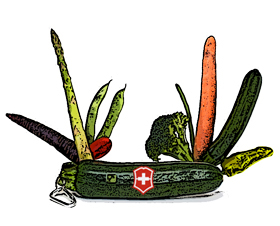The Neutral Effect In Food and Wine Pairing.
The impact of the chemical reactions taking place in your mouth when you combine food and wine can be very obvious when you’re experiencing the cancellation effect or the cumulative effect, but there’s another interaction between food and wine that’s just as rewarding, but much less pronounced. I call this subtle interplay the neutral effect. I realize that describing a food and wine pairing as neutral sounds sort of, well … neutral, but that doesn’t mean these combinations are boring. Neutral pairings occur when similar flavors come together in a safe, reassuring place, sort of like Switzerland.
Neutral tastes don’t accumulate or cancel one another out but because they are delicate they can be easily overpowered by the cancellation or cumulative effects. The neutral effect is best illustrated by the heightened impact and satisfying gratification attained when umami-rich foods are matched with wines featuring umami characteristics.
“Older, earthier, less fruity wines tend to deliver more umami, and pair better with a wider range of foods,” writes David and Anna Kasabian in The Fifth Taste, Cooking With Umami. When considering a subtly flavored braised beef, served in a complex reduction of vegetables and seasonings, a tannic Cabernet Sauvignon, “might taste aggressively coarse and unbalanced with the umami of the dish. On the other hand, a fifteen-year old French Bordeaux has had the opportunity to create harmonious balance among its tastes, umami included, and actually goes well with (the) dish.”¹
A wine that smells of mushrooms and forest floor will share a certain kinship with mushroom dishes. The morel of this story is; rustic foods have an affinity with earthy, rustic wines because of the comfortable combination of similar tastes. If you combine this knowledge with what you’ve learned about weight pairing you can pick the right wine for any meal featuring earthy flavors. If your dish is delicate you could opt for the mushroom-like flavors of an aged, light-bodied Pinot Noir. If it’s a medium-bodied meal, a middleweight Bordeaux, redolent of earthy truffles and damp earth will meet your requirements, and if you’re enjoying a hearty meal, a gamy, full-bodied country wine from southern Italy works nicely. The distinctive umami flavor of the meal dictates a similarly flavored wine, while the weight of the food helps you fine tune your wine selection.
Keep in mind the cancellation and cumulative effects may come into play with neutral pairings if sweet, sour, bitter or piquant characteristics are present. When you pair an aged, umami-rich red with an umami-laden dish like Shiitake mushrooms, the palate pleasing umami taste can soften, allowing it to succumb to these other tastes, possibly disrupting the delicate umami love-fest taking place in your mouth.
When paired with umami dishes, sweet or sour wines (those wines that are subject to the cancellation effect) will behave better than wines that fall under the cumulative effect (tannic and overly alcoholic wines). Sweet tastes in wine will be heightened, creating a rich, fruit characteristic, while sour wine tastes will soften and become more agreeable. On the other hand, the taste of bitter tannins or alcohol will be magnified and may result in a metallic flavor or a hot sensation.
• Summary: When umami tastes in food and wine are joined they don’t build or cancel each other, they enhance the enjoyment of both. Neutral pairings heighten the impact of similar tastes, contributing to a rich mouthfeel and stimulating satiety. Foods high in umami lend themselves to neutral pairings with aged reds and yeasty whites and may increase your perception of bitterness or piquance in tannic and overly alcoholic wines.
¹ Kasabian, D. and Kasabian, A. (2008) The Fifth Taste, Cooking With Umami, 32, 33






















